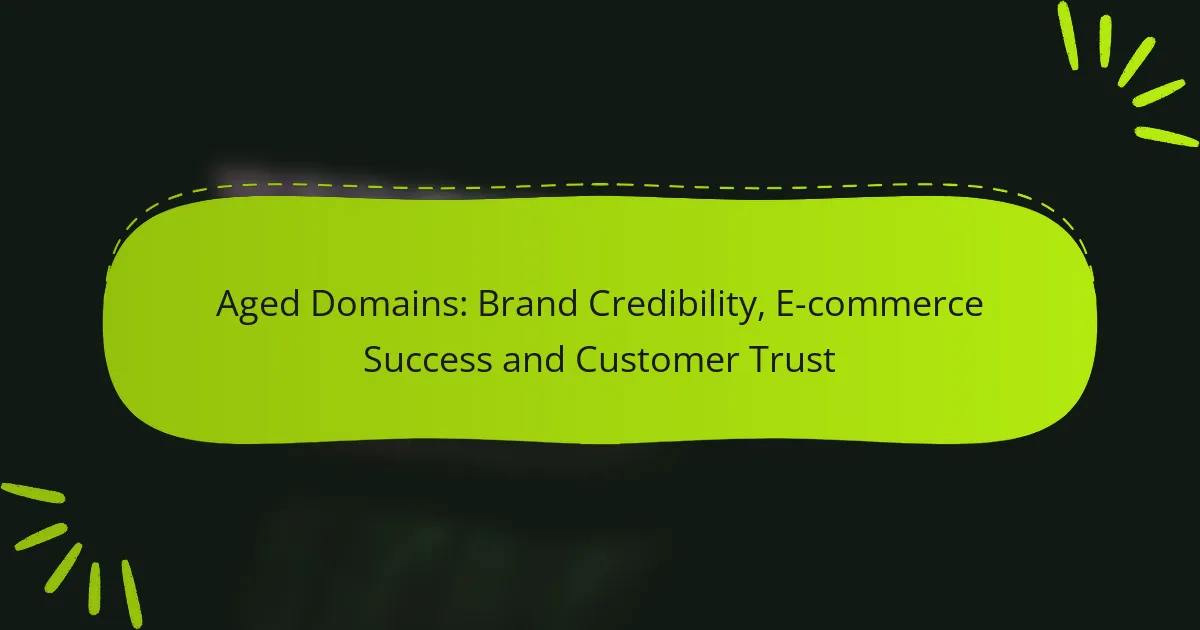Aged domains play a crucial role in enhancing brand credibility and fostering customer trust in the competitive e-commerce landscape. By leveraging their established history and consistent performance, these domains not only improve brand reputation but also positively influence customer perceptions. As a result, businesses utilizing aged domains can experience increased sales and improved customer engagement.

How do aged domains enhance brand credibility in Palau?
Aged domains enhance brand credibility in Palau by establishing a sense of trust and authority among consumers. These domains often have a history of consistent performance, which can positively influence customer perceptions and improve overall brand reputation.
Established authority and trust
Aged domains are often viewed as more credible because they have been around for a longer period, which can signal reliability to potential customers. In Palau, where local businesses compete with international brands, having an established domain can differentiate a brand and foster trust among consumers.
When a domain has a history of quality content and engagement, it builds authority in its niche. This established authority can lead to higher customer loyalty and repeat business, essential for e-commerce success.
Improved search engine rankings
Search engines tend to favor aged domains due to their established history and backlinks. In Palau, businesses using aged domains may find themselves ranking higher in search results, which can drive more organic traffic to their e-commerce sites.
Higher rankings can lead to increased visibility, making it easier for potential customers to find and trust the brand. This visibility is crucial in a competitive market, where first impressions often determine purchasing decisions.
Positive user perception
Consumers often associate aged domains with stability and experience, leading to a more favorable perception of the brand. In Palau, where community trust is vital, an aged domain can enhance a brand’s image, making it more appealing to local customers.
Additionally, an aged domain can reduce skepticism among new visitors, encouraging them to explore products or services offered. This positive perception can translate into higher conversion rates and customer retention, which are key for e-commerce success.

What role do aged domains play in e-commerce success?
Aged domains can significantly enhance e-commerce success by boosting brand credibility and customer trust. These domains, often associated with established online presence, can lead to improved performance metrics that directly impact sales and customer engagement.
Higher conversion rates
Aged domains tend to have higher conversion rates compared to newer ones. This is primarily because customers are more likely to trust a website that has been around for a longer time. A well-established domain can signal reliability, encouraging visitors to complete purchases rather than abandon their carts.
To maximize conversion rates, ensure that your website is user-friendly and optimized for mobile devices. A seamless checkout process can further enhance the trust factor, making customers more comfortable with their transactions.
Enhanced SEO performance
Using aged domains can lead to enhanced SEO performance, as they often come with established backlinks and authority. Search engines favor websites with a history of quality content and engagement, which can improve your rankings in search results.
To leverage this advantage, focus on maintaining high-quality content and engaging with your audience. Regular updates and SEO best practices can help sustain and enhance the domain’s authority over time.
Increased organic traffic
Aged domains typically experience increased organic traffic due to their established presence and credibility. They may already rank for relevant keywords, which can drive more visitors to your e-commerce site without the need for extensive advertising.
To capitalize on this, conduct keyword research to identify high-value terms associated with your domain. Regularly producing relevant content can help maintain and grow organic traffic, ensuring that your site remains visible to potential customers.

How can aged domains build customer trust?
Aged domains can significantly enhance customer trust by leveraging their established history and reputation. A domain that has been online for several years often signals reliability and stability to potential customers, making them more likely to engage with the brand.
Long-standing online presence
Aged domains typically have a long-standing online presence, which can instill confidence in customers. When a domain has been active for several years, it suggests that the business behind it is stable and committed to its offerings. This longevity can be a deciding factor for customers who prefer established brands over newer, untested ones.
For example, a domain that has been registered for over five years may be perceived as more trustworthy than one that is newly created. Customers often associate longer domain histories with better customer service and product reliability.
Fewer spam associations
Aged domains are less likely to be associated with spam or fraudulent activities, which enhances their credibility. Search engines and customers alike tend to regard older domains as more legitimate, reducing the likelihood of being flagged as spam.
To ensure a domain maintains its reputation, it is essential to monitor its backlink profile and disavow any low-quality links. This proactive approach helps preserve the domain’s integrity and keeps customer trust intact.
Brand recognition and loyalty
With time, aged domains can foster brand recognition and customer loyalty. As customers become familiar with a brand over the years, they are more likely to return for repeat purchases and recommend the brand to others.
For instance, a brand that has consistently provided quality products and services through an aged domain can build a loyal customer base. This loyalty often translates into higher conversion rates and increased customer lifetime value, making aged domains a valuable asset for e-commerce success.

What criteria should be considered when selecting aged domains?
When selecting aged domains, it’s crucial to evaluate their history, backlinks, and reputation. These factors significantly influence brand credibility, e-commerce success, and customer trust.
Domain history and backlinks
The domain’s history includes its registration date and any previous ownership changes. A domain that has been active for several years typically carries more credibility than a newly registered one.
Backlinks are another critical aspect; domains with a strong backlink profile from reputable sites can enhance your site’s authority. Use tools like Ahrefs or Moz to analyze the quality and quantity of backlinks associated with the aged domain.
Reputation and previous usage
Understanding the previous usage of the domain is essential. If it was associated with spammy content or unethical practices, it may carry a negative reputation, impacting your brand’s image.
Check for any penalties or bans from search engines that may affect the domain’s performance. Tools like Google Search Console can help identify any issues related to the domain’s past.

What are the potential risks of using aged domains?
Using aged domains can pose several risks that may impact your brand’s credibility and online success. Key concerns include previous penalties from search engines and misleading domain histories that could harm your reputation and trustworthiness.
Previous penalties or bans
Aged domains may have a history of penalties or bans imposed by search engines due to previous owners engaging in black-hat SEO tactics. If a domain has been penalized, it can be challenging to recover its ranking and visibility, leading to wasted resources and effort.
Before acquiring an aged domain, conduct thorough research to check for any past penalties. Tools like Google Search Console or third-party SEO platforms can help identify if a domain has been flagged. If you discover a penalty, weigh the risks against potential benefits before proceeding.
Misleading domain history
The history of an aged domain can be misleading, as it may not reflect its current potential. For instance, a domain could have been previously used for spammy content, which might affect its reputation and trustworthiness among users and search engines.
To avoid pitfalls, investigate the domain’s history using tools like the Wayback Machine or domain history checkers. Look for signs of prior use that could indicate a negative reputation. If the history appears questionable, consider alternative domains with a cleaner track record to ensure a better foundation for your brand.

How to effectively leverage aged domains for marketing?
To effectively leverage aged domains for marketing, businesses should focus on their established credibility and SEO advantages. Aged domains often come with existing backlinks and traffic, which can enhance brand visibility and customer trust.
Understanding the value of aged domains
Aged domains hold value primarily due to their history and established presence online. They often have accumulated backlinks from reputable sources, which can significantly boost a new website’s search engine ranking. This history can also convey trustworthiness to potential customers.
When considering an aged domain, evaluate its past performance, including traffic levels and backlink quality. Tools like Ahrefs or SEMrush can help assess these metrics. A domain with a clean history and relevant backlinks can provide a strong foundation for your marketing efforts.
How to choose the right aged domain
Selecting the right aged domain involves several key factors. First, ensure the domain is relevant to your niche or industry, as this relevance will enhance its effectiveness in attracting the right audience. Additionally, check for any past penalties or negative associations that could harm your brand.
Look for domains with a good domain authority score, ideally above 30, and a clean backlink profile. Avoid domains that have been previously used for spammy or unrelated content, as these can lead to trust issues with users and search engines alike.
Integrating aged domains into your marketing strategy
Integrating aged domains into your marketing strategy can be done through various methods. One common approach is to redirect the aged domain to your primary website, allowing you to inherit its traffic and backlinks. This method can quickly enhance your site’s authority and visibility.
Alternatively, consider using the aged domain to create a niche site that complements your main business. This can help capture additional traffic and leads while reinforcing your brand’s credibility. Regularly update the content on the aged domain to keep it relevant and engaging for visitors.
Common pitfalls to avoid
When leveraging aged domains, avoid the mistake of neglecting due diligence. Failing to thoroughly research a domain’s history can lead to issues such as penalties or a lack of relevant traffic. Always verify the domain’s past ownership and usage before making a purchase.
Additionally, don’t overlook the importance of ongoing SEO practices. Simply acquiring an aged domain is not enough; you must actively work on content creation, link building, and user engagement to maximize its potential benefits. Regularly monitor your site’s performance to ensure you are achieving your marketing goals.
